Related Research Articles

Ernest Gary Gygax was an American game designer and author best known for co-creating the pioneering tabletop role-playing game Dungeons & Dragons (D&D) with Dave Arneson.
Greyhawk, also known as the World of Greyhawk, is a fictional world designed as a campaign setting for the Dungeons & Dragons fantasy roleplaying game. Although not the first campaign world developed for Dungeons & Dragons—Dave Arneson's Blackmoor campaign predated it by about a year—the world of Greyhawk closely identified with early development of the game beginning in 1972, and after being published it remained associated with Dungeons & Dragons publications until 2008. The world itself started as a simple dungeon under a castle designed by Gary Gygax for the amusement of his children and friends, but it was rapidly expanded to include not only a complex multi-layered dungeon environment, but also the nearby city of Greyhawk, and eventually an entire world. In addition to the campaign world, which was published in several editions over twenty years, Greyhawk was also used as the setting for many adventures published in support of the game, as well as for RPGA's massively shared Living Greyhawk campaign from 2000–2008.

TSR, Inc. was an American game publishing company, best known as the original publisher of Dungeons & Dragons (D&D). Its earliest incarnation, Tactical Studies Rules, was founded in October 1973 by Gary Gygax and Don Kaye. Gygax had been unable to find a publisher for D&D, a new type of game he and Dave Arneson were co-developing, so he founded the new company with Kaye to self-publish their products. Needing financing to bring their new game to market, Gygax and Kaye brought in Brian Blume in December as an equal partner. Dungeons & Dragons is generally considered the first tabletop role-playing game (TTRPG), and established the genre. When Kaye died suddenly in 1975, the Tactical Studies Rules partnership restructured into TSR Hobbies, Inc. and accepted investment from Blume's father Melvin. With the popular D&D as its main product, TSR Hobbies became a major force in the games industry by the late 1970s. Melvin Blume eventually transferred his shares to his other son Kevin, making the two Blume brothers the largest shareholders in TSR Hobbies.
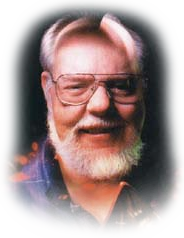
David Lance Arneson was an American game designer best known for co-developing the first published role-playing game (RPG), Dungeons & Dragons, with Gary Gygax, in the early 1970s. Arneson's early work was fundamental to the role-playing game (RPG) genre, pioneering devices now considered to be archetypical, such as cooperative play to develop a storyline instead of individual competitive play to "win" and adventuring in dungeon, town, and wilderness settings as presented by a neutral judge who doubles as the voice and consciousness of all characters aside from the player characters.
Tom Wham is a designer of board games who has also produced artwork, including that for his own games.
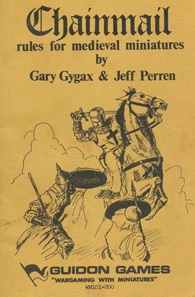
Chainmail is a medieval miniature wargame created by Gary Gygax and Jeff Perren. Gygax developed the core medieval system of the game by expanding on rules authored by his fellow Lake Geneva Tactical Studies Association (LGTSA) member Jeff Perren, a hobby-shop owner with whom he had become friendly. Guidon Games released the first edition of Chainmail in 1971.
In the World of Greyhawk campaign setting for the Dungeons & Dragons roleplaying game, Tenser is an archmage who strives to rid the Flanaess of evil. Tenser is a former member of both the Citadel of Eight and the Circle of Eight.
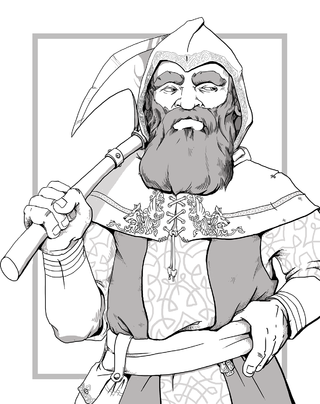
A dwarf, in the Dungeons & Dragons (D&D) fantasy roleplaying game, is a humanoid race, one of the primary races available for player characters. The idea for the D&D dwarf comes from the dwarves of European mythologies and J. R. R. Tolkien's novel The Lord of the Rings (1954-1955), and has been used in D&D and its predecessor Chainmail since the early 1970s. Variations from the standard dwarf archetype of a short and stout demihuman are commonly called subraces, of which there are more than a dozen across many different rule sets and campaign settings.
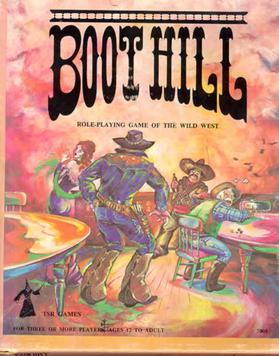
Boot Hill is a western-themed role-playing game designed by Brian Blume, Gary Gygax, and Don Kaye, and first published in 1975. Boot Hill was TSR's third role-playing game, appearing not long after Dungeons & Dragons (D&D) and Empire of the Petal Throne, and taking its name from "Boot Hill", the popular Wild West term for "cemetery". Boot Hill was marketed to take advantage of America's love of the western genre. The game did feature some new game mechanics, such as the use of percentile dice, but its focus on gunfighting rather than role-playing, as well as the lethal nature of its combat system, limited its appeal. Boot Hill was issued in three editions over 15 years, but it never reached the same level of popularity as D&D and other fantasy-themed role-playing games.
The Lake Geneva Tactical Studies Association (LGTSA) was a wargaming club active in Lake Geneva, Wisconsin during the early 1970s.
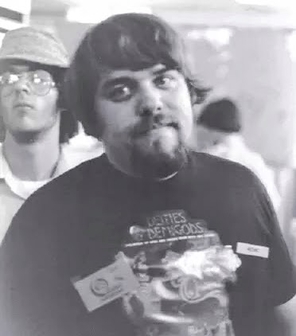
James Michael Ward III was an American game designer and fantasy author who worked for TSR, Inc. for more than 20 years, most notably on the role-playing game Dungeons & Dragons. He wrote various books relating to Dungeons & Dragons, including guidebooks such as Deities & Demigods, and novels including Pool of Radiance, based on the computer game of the same name.

Robert J. Kuntz is a game designer and author of role-playing game publications. He is best known for his contributions to various Dungeons & Dragons-related materials.
The legion of fictional deities in the World of Greyhawk campaign setting for the Dungeons & Dragons fantasy roleplaying game covers an extensive range of spheres of influence, allowing players to customize the spiritual beliefs and powers of their characters, and as well as giving Dungeon Masters a long list of gods from which to design evil temples and minions. Although the Greyhawk campaign world, when it was merely a home game, started with no specific gods, the value of having deities available for both players and game plot purposes was quickly realized. The number of deities has varied with each version of the campaign world that has been published, but for many years numbered a few dozen. It has only been since 1999 that the number of gods increased dramatically to almost 200, due to the volume of newly published material that was subsequently integrated into the campaign world.
Donald R. Kaye was the co-founder of Tactical Studies Rules (TSR), the game publishing company best known for their Dungeons & Dragons (D&D) role-playing game. He and TSR co-founder Gary Gygax had been friends since childhood, sharing an interest in miniature war games. In 1972, Kaye created Murlynd, one of the first D&D characters, and play-tested him in Gygax's Castle Greyhawk campaign. Kaye and Gygax were convinced that D&D and similar games were an excellent business opportunity, and together they founded Tactical Studies Rules in 1973. However, only two years later, just as sales of D&D started to rise, Kaye unexpectedly died of a heart attack at age 36.
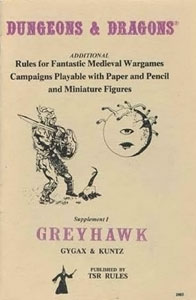
Greyhawk is a supplementary rulebook written by Gary Gygax and Robert J. Kuntz for the original edition of the Dungeons & Dragons (D&D) fantasy role-playing game. It has been called "the first and most important supplement" to the original D&D rules. Although the name of the book was taken from the home campaign supervised by Gygax and Kuntz based on Gygax's imagined Castle Greyhawk and the lands surrounding it, Greyhawk did not give any details of the castle or the campaign world; instead, it explained the rules that Gygax and Kuntz used in their home campaign, and introduced a number of character classes, spells, concepts and monsters used in all subsequent editions of D&D.

Swords & Spells is a supplementary rulebook by Gary Gygax for the original edition of the Dungeons & Dragons fantasy role-playing game. Its product designation is TSR 2007.
Brian John Blume was an American game designer and writer, principally known as a former business partner of Gary Gygax at TSR, Inc., original publishers of the fantasy role-playing game Dungeons & Dragons.
Jeff Perren is a game designer, a hobby shop owner, and an early associate of Gary Gygax.
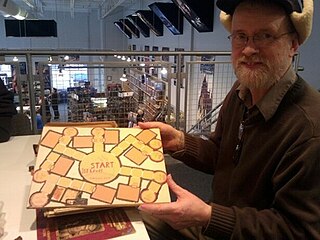
David R. Megarry is a game designer most notable for the board game Dungeon!.
References
- 1 2 3 4 Kask, Tim (December 1975). "In the Cauldron". The Strategic Review (#5). Lake Geneva, Wisconsin: TSR, Inc.: 2, 8.
- ↑ Livingstone, Ian (August–September 1979). "White Dwarf interviews Gary Gygax". White Dwarf (14). London: Games Workshop: 23–24.
- ↑ Gygax: "In a couple of days time Don Kaye (Murlynd), Rob (Robilar, Otto) and Terry (Terik) Kuntz joined the gang." "Gary Gygax: Q & A (Part I, Page 8)". EN World. 2006-08-06. Retrieved 2009-03-15.
- 1 2 Shannon Appelcline (2011). Designers & Dragons. Mongoose Publishing. ISBN 978-1-907702-58-7.
- ↑ "Gary Gygax Interview" . Retrieved 2007-02-19.